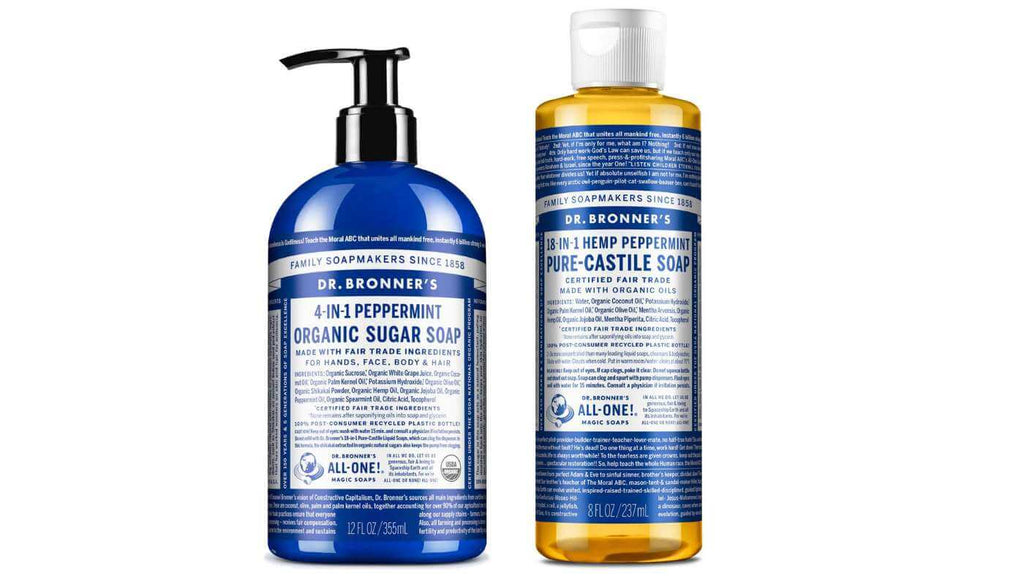Dr Bronner's: Castile Soaps vs Pump Soaps (What's the Difference?)
May 07, 2018
You’ve probably heard about Dr Bronner's soaps. This family-owned company has been in business since 1948, and they're one of my favourite ethical brands. Dr Bronner’s castile soaps have been around from the start, but the pump soaps are a more recent addition. So what's the difference between the two?
The castile soap is the result of generations of soap making expertise. Dr Bronner’s castile soaps are pure, and that purity means that you can use them for so many different things. So why make a new type of soap when the castile soap is so good? Dr Bronner's say that over the years many people have asked for a thicker, more moisturising soap. They wanted one that could be used with a pump dispenser, and a soap that is USDA certified organic. (The pure castile soap is not USDA certified. The water and saponification agents used in manufacture are inorganic and can’t go towards the 95% organic ingredients necessary to get the USDA label.)

About Dr Bronner's Pump Soap
Which is where Dr Bronner's pump soap comes in. It’s made with shikakai, a form of Acacia concinna, an Ayurvedic medicinal plant that has been used in skin and hair care for hundreds of years. The bark is powdered and added to the soap for its moisturising effects, as well as acting as a thickener. It also has antifungal properties that make it a great dandruff shampoo for non colour treated hair. If you find the castile soap a little dry for personal care, you’ll like the pump soap. I’ve never found Dr Bronner’s castile soap drying, even with my super dry skin. But I’ve been trying the pump soap in the shower, and I do like the extra hydration. In addition to the shikakai, the pump soap also contains organic grape juice and sucrose. These ingredients act as humectants, helping the skin hold on to its natural moisture (and incidentally bringing the tally of organic ingredients up over 95%, making this soap USDA organic). Let's compare the ingredients:
Pure Castile Soaps vs. Pump Soaps
Dr Bronner's Pure Castile Soap
water, coconut oil* potassium hydroxide* olive oil* hemp oil* jojoba oil* citric acid* tocopherol (vitamin E)*Dr Bronner's Pump Soap
organic grape juice, sucrose, coconut oil* potassium hydroxide* olive oil* shikakai powder, hemp oil* jojoba oil* salt citric acid* tocopherol (vitamin E)* * USDA certified organic
As you can see, they’re very similar. The main difference between the two (aside from the moisturising) is in the look, scent, and texture. The pump soap looks quite different from the clear pure castile soap, since the shikakai is brown and about the consistency of cinnamon powder. The formulation of the peppermint pump soap is different, using a different mint blend with spearmint oil, so it’s not as cooling as the pure castile soap version.
Classic Dr Bronner’s castile soap is only suitable for foam pump dispensers (diluted with three times as much water). If you use it in a normal pump dispenser, it tends to get clogged, which can be frustrating. The pure castile soap also makes a better household cleaner, since bathrooms, dishes and countertops don’t need moisturising.
In general, whether you use the pump soap or pure castile soap is a matter of personal preference based on how your skin reacts – they’re both great cleansers. Dr Bronner’s make great soaps, whether it’s the castile soap, the pump soap or the bar soaps. But the rest of the range is pretty fantastic, too! Try the bestselling hand sanitiser, my family’s favourite natural toothpaste, or the lovely all purpose magic balm. You can check out the Dr Bronner’s range here at Hello Charlie.

